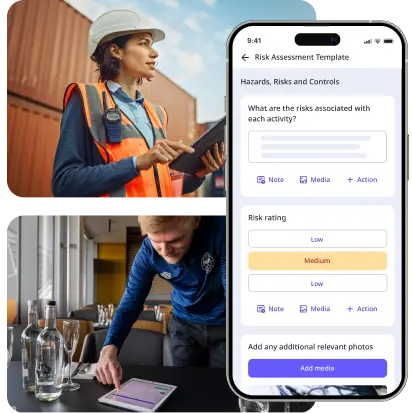What is a Food Poisoning Investigation Checklist?
A food poisoning investigation checklist is a document that outlines the steps to be taken when investigating a suspected food poisoning incident. It helps in identifying the source of the contamination, assessing the hygiene practices, and ensuring the safety of customers and members of an organization or business.
Importance and Benefits
An estimate of 48 million Americans experience food poisoning yearly. Food poisoning is a type of foodborne illness that happens when humans ingest toxins created by microorganisms and bacteria found in food. Sometimes called foodborne intoxication, food poisoning can lead to many complications such as muscle paralysis and respiratory failure if left untreated. For this reason, it’s essential to investigate its causes to ensure customer and workplace safety.
A food poisoning investigation checklist provides a structured and systematic approach to investigating food safety incidents that cause foodborne intoxication. This document helps determine the scale of the investigation, ensuring that all necessary steps are taken, and no critical information is missed. By following a checklist, food establishments can ensure compliance with food safety regulations and standards, reducing the risk of legal and regulatory issues.
Additionally, regular use of checklists helps in maintaining good hygiene practices, proper food handling, and kitchen sanitation, which are essential for preventing foodborne illnesses. Detailed documentation of the investigation process, including information gathered, actions taken, and test results, is crucial for identifying the source of contamination and taking corrective actions.
What to Include in a Food Poisoning Investigation Checklist
Different organizations will have different ways to investigate food poisoning. However, an effective food poisoning investigation checklist should contain fields for the following:
- Name of evaluator
- Date of evaluation
- Number of affected individuals
- Onset of symptoms
- Common food items consumed by individuals
- Evaluation on the following:
- Compliance with food safety and handling practices
- Compliance with temperature and storage standards
- Care for affected individuals
- Testing procedures
- Contacting and collaborating with local authorities
- Steps moving forward
- Comments and recommendations
- Evaluator name and signature
Here is a sample food poisoning investigation checklist in use:
How to Use
To use a food poisoning investigation checklist effectively, follow these steps:
- Document incident details: Take note of the date the incident could’ve happened, as well as the possible causes of food poisoning and how many were affected. Make sure to also note the symptoms experienced by the affected individuals, such as nausea, vomiting, diarrhea, fever, and headache.
- Use your checklist: Trace your steps and that of your food provider’s to see if all food handling procedures were properly followed. Check if raw ingredients were stored properly, verify if there was any potential for cross-contamination, and ensure that cooking temperatures and travel temperatures were maintained.
- Collect samples: Test suspected food item(s) for laboratory testing, as well as stool or blood samples from affected individuals for cross-reference. This step can also be included in your food poisoning investigation checklist to ensure it’s complied with.
- Notify relevant authorities: Contact your local health department or food safety agency about the incident.
- Create and implement follow-up actions: Document all corrective actions taken to prevent future incidents. Conduct increased inspections to monitor the establishment’s compliance with food safety regulations.
You can also use your food poisoning investigation checklist in conjunction with a digital platform that allows you to monitor your food in real-time. With a solution such as SafetyCulture, you can centralize your temperature monitoring sensors’ readings and your food safety documents in one place. Doing so allows you to keep track of changes that can lead to foodborne illnesses and easily addressing them as you see them.
FAQs about Food Poisoning Investigation Checklists
What tests are done to diagnose food poisoning?
Who investigates cases of food poisoning in an organization?
Who manages the food poisoning investigation checklist?




